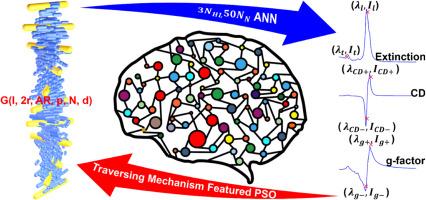利用人工神经网络揭示金纳米棒螺旋组件的几何依赖光学不对称性
IF 8
2区 计算机科学
Q1 AUTOMATION & CONTROL SYSTEMS
Engineering Applications of Artificial Intelligence
Pub Date : 2025-09-29
DOI:10.1016/j.engappai.2025.112513
引用次数: 0
摘要
金纳米棒(Au-NRs)螺旋组件的光学不对称性已被充分证明,具有广泛的应用。然而,这些组件中几何相关的光学不对称性尚未得到充分的探索和量化。本研究提出了一种基于几何特征的人工神经网络(ANN)预测au - nmr螺旋组件光学不对称性的新方法。通过对隐藏层和节点的优化,3NHL50NN的性能得到了显著增强,结果的R2超过0.998,计算时间减少超过99.99%。在需要特定几何特征以获得期望的光学不对称的情况下,使用具有粒子群优化(PSO)算法的遍历机制对Au-NRs螺旋组件的几何特征进行了额外的研究。检索结果在6 s内获得,具有较高的准确性和可靠性。结合3NHL50NN和PSO算法,能够准确预测Au-NRs螺旋组件的光学不对称性,并检索其几何特征,从而定量了解其整体几何相关的光学不对称性。本文章由计算机程序翻译,如有差异,请以英文原文为准。

Uncovering the geometry-dependent optical asymmetry of gold nanorods helical assemblies using artificial neural networks
The optical asymmetry of gold nanorods (Au-NRs) helical assemblies is well-documented with a wide range of applications. Nevertheless, the geometry-dependent optical asymmetry within these assemblies has not been adequately explored and quantified. The present study proposes a novel approach to predict the optical asymmetry of Au-NRs helical assemblies based on geometric characteristics using artificial neural networks (ANN). The performance of the ANN termed was significantly enhanced through the optimization of the hidden layer and node, resulting in an R2 of the outcomes exceeding 0.998 and a reduction in computational time exceeding 99.99 %. In instances where the specific geometric characteristics are needed to attain a desired optical asymmetry, a retrieval of geometric characteristics of Au-NRs helical assemblies was additionally investigated using a traversing mechanism featured particle swarm optimization (PSO) algorithm. The results of the retrieval were obtained within 6 s and demonstrate a high degree of accuracy and reliability. The combination of the and the PSO algorithm is capable of accurately predicting the optical asymmetry of Au-NRs helical assemblies and the retrieval of the geometry characteristics, thereby enabling the quantitative understanding of their overall geometry-dependent optical asymmetry.
求助全文
通过发布文献求助,成功后即可免费获取论文全文。
去求助
来源期刊

Engineering Applications of Artificial Intelligence
工程技术-工程:电子与电气
CiteScore
9.60
自引率
10.00%
发文量
505
审稿时长
68 days
期刊介绍:
Artificial Intelligence (AI) is pivotal in driving the fourth industrial revolution, witnessing remarkable advancements across various machine learning methodologies. AI techniques have become indispensable tools for practicing engineers, enabling them to tackle previously insurmountable challenges. Engineering Applications of Artificial Intelligence serves as a global platform for the swift dissemination of research elucidating the practical application of AI methods across all engineering disciplines. Submitted papers are expected to present novel aspects of AI utilized in real-world engineering applications, validated using publicly available datasets to ensure the replicability of research outcomes. Join us in exploring the transformative potential of AI in engineering.
 求助内容:
求助内容: 应助结果提醒方式:
应助结果提醒方式:


